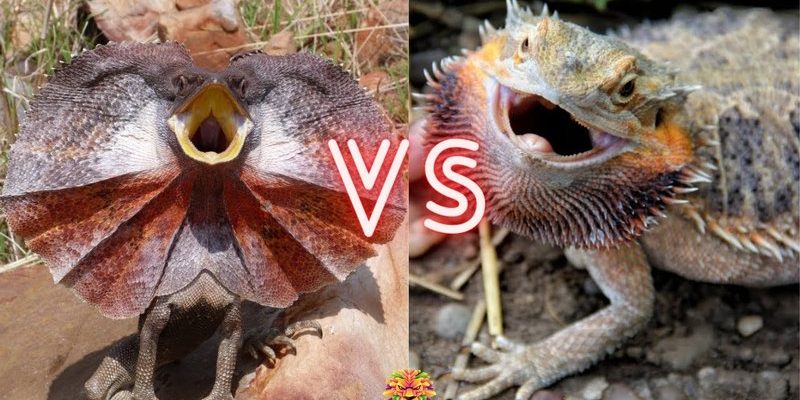![Comparing The Frilled Lizard Vs. [Similar Species]](https://gudri.com/wp-content/uploads/2025/06/Comparing_The_Frilled_Lizard_Vs___Similar_Species__image_0.jpg)
So, what exactly sets these two apart? Let’s dive into their habitats, behaviors, and characteristics to shed some light on how they compare!
Natural Habitat: Where Do They Live?
The Frilled Lizard, native to the tropical forests of northern Australia and New Guinea, is often found in trees. It prefers moist environments where it can blend seamlessly with the foliage. You might picture it lounging on a branch, waiting patiently for its next meal. Its ability to camouflage is a true lifesaver in the wild!
On the flip side, the Blue-Tongued Skink is more versatile in its habitat choices. This reptile can be found in various environments, from woodlands to grasslands and even suburban backyards. Its adaptability makes it less picky about where it sets up camp. Imagine a lizard that enjoys both the comfort of nature and the occasional human garden—it’s a little more social than its frilled counterpart!
Physical Characteristics: How Do They Look?
Visually, these lizards are strikingly different. The Frilled Lizard is easily recognized by the large skin fold that surrounds its neck, which can be expanded into a frill when threatened. It’s a dramatic look—like it’s wearing a regal collar! This impressive feature not only makes it look bigger and scarier to potential predators but also plays a crucial role in attracting mates.
In contrast, the Blue-Tongued Skink features a stocky body and short legs, but its most notable feature is undoubtedly its vibrant blue tongue. When threatened, it will stick out its tongue as a warning, showcasing its bright color to scare off predators. It’s like a little lizard with a big personality, using its looks to say, “Stay back!”
Behavior: How Do They Act?
Behavior-wise, these lizards take different approaches to survival. The Frilled Lizard is known for its rather theatrical flair: when it feels threatened, it will unfurl its frill and hiss loudly. It might even perform a few impressive displays of its agility in an effort to intimidate whatever is bothering it. Honestly, you could say it’s the drama queen of the reptile world!
Now, the Blue-Tongued Skink has a more laid-back attitude. Instead of puffing up and posturing, it often opts to freeze or slowly move away when scared. If pushed, it will flash its blue tongue, but you won’t find it jumping around in sheer panic. Instead, it’s more like, “Hey, I see you, but I’d rather just chill.”
Diet: What Do They Eat?
When it comes to food, both species have different tastes. The Frilled Lizard primarily eats insects, taking advantage of its climbing skills to hunt down critters in the trees. Picture it darting through branches to catch a juicy grasshopper—now that’s a meal!
On the other hand, the Blue-Tongued Skink has a more varied diet. It enjoys a mix of fruits, vegetables, and insects. This makes it a bit more of a culinary explorer, able to munch on a wide range of goodies. If you had to cook for either of these lizards, the skink would be much easier to please!
Colors and Patterns: What Makes Them Unique?
These lizards also differ in their colors and patterns. The Frilled Lizard typically sports earthy tones, like browns and olives, that help it blend into its natural surroundings. This is crucial for evading predators. Its frill, when it’s not expanded, lies flat against its neck, helping it remain inconspicuous while perched on a branch.
Conversely, the Blue-Tongued Skink offers more variety in its appearance. It comes in various colors, including shades of brown, gray, and even some with striking patterns. The combination of its vibrant blue tongue and intriguing patterns makes it a standout among reptiles, drawing in enthusiasts and casual observers alike.
Keeping Them as Pets: Are They Good Choices?
If you’re considering adding one of these fascinating lizards to your home, it’s essential to know what you’re getting into. The Frilled Lizard can be a bit more challenging as a pet. Its habitat needs and temperament mean it requires more care and attention. You’ll need a large enclosure with climbing opportunities, and it may not enjoy regular handling.
On the other hand, Blue-Tongued Skinks are generally more adaptable and social, making them a more popular choice for reptile enthusiasts. They tend to be easier to handle and can have friendly personalities. With proper care, they can become quite the charming companion in your home.
Conservation Status: Are They Threatened?
Lastly, considering their conservation status is vital. The Frilled Lizard is not currently considered endangered, but habitat loss and climate change could pose risks in the future. It’s essential to protect their forest habitats to ensure they continue thriving.
The Blue-Tongued Skink is also in a stable condition but faces threats from habitat destruction and the pet trade. Understanding their needs and supporting conservation efforts can help ensure these unique lizards stay around for future generations to admire.
In summary, while the Frilled Lizard and Blue-Tongued Skink may share some similarities as reptiles, their differences in habitat, behavior, and care requirements make each a unique marvel of nature. Whether you’re drawn to the dramatic flair of the Frilled Lizard or the friendly demeanor of the Blue-Tongued Skink, just remember to appreciate their unique charms!

